
Ginbura Hyakunen
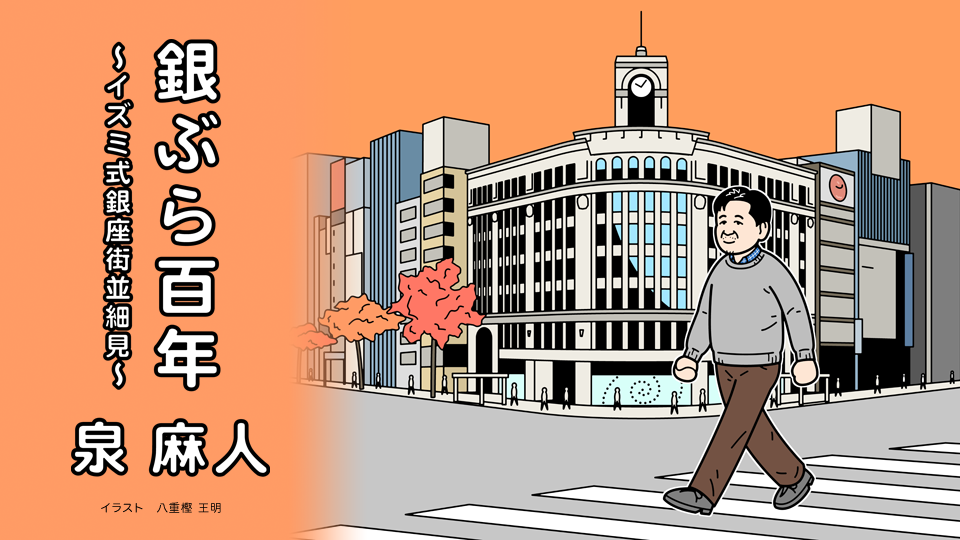
Ginza×銀ぶら百年 Vol.26
銀ぶら百年 ~イズミ式銀座街並細見~
The King of Mingei on Nishiginza-dori
2020.09.25
Walking towards Shinbashi along Nishiginza (Sotobori)-dori, you can find an old Mingei store with a sign that says “TAKUMI” as you enter the 8-chome block. I had always vaguely imagined that it had originally opened for foreign tourists around the Tokyo Olympics, just like the International Arcade that stretched under the elevated railway tracks behind Corridor Street until just recently. However, I was told that the TAKUMI was established in 1933 (Showa 8), even before World War II. The store was first opened in a two-story building located closer to Shinbashi, two or three buildings away from the corner near Dobashi Bridge, a bridge that is no longer there.
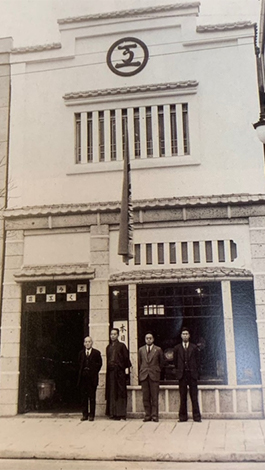
TAKUMI around its establishment
When I visited the store for an interview, I first had a chat with Mr. Susumu Segawa, an experienced storekeeper in charge of the first floor. According to Mr. Segawa, they had operated in the old store until the first Recruit building was constructed on the corner near Dobashi Bridge in the 1970s. Mr. Segawa joined the store 52 years ago, which would be in 1968, just around the time I became curious about the Mingei store that opened in my neighborhood when I was in sixth grade. I don’t remember exactly whether it was the “Kanbara” card from Hiroshige’s “Tokaido Gojusantsugu” series (“Nagatanien Ochazuke Nori” came with a random card, which created a boom) or Shigeru Mizuki’s spirits and monsters that deeply attracted me to the old umbrella that was displayed in the store. I would often stop by the Mingei store just to gaze at it. Simple and retro-inspired Mingei items had slowly become a trend as Japan celebrated i the centennial anniversary of the dawn of the Meiji period. I recall purchasing a pottery bell at the store, in an attempt to appear a little sophisticated, when I was invited to a birthday party for one of my close female friends (a member of a band I had formed with a group of friends to play “group sound” music). Yet my Mingei hobby did not go very far.
Inside the store, small items such as rice bowls, small plates, and tenugui towels (as well as Mingei design face masks) are sold on the first floor. Walking upstairs to the second floor, one can find clothing and larger objects, including Southeast Asian textiles, on display. (I was in shock for a moment when I found the “Marijuana cloth” hemp jacket from the Thai Meo Hill tribe.) I interviewed the current CEO, Mr, Jun Nozaki, sitting at a table in the corner on the second floor, going through old materials and photographs.
“We still write “Shokoku-mingei” (Mingei from around the world) before our name TAKUMI. Now, the word “mingei” was first coined by Soetsu Yanagi, and pottery artisans Shoji Hamada and Kanjiro Kawai.”
Initially, they said “Mingei-teki kogei,” or folkart-like crafts, and as the name implies, it was rooted in a social movement to promote the artistic quality of livingware that is ingrained among the common people. The movement intensified from the end of the Meiji period through the Taisho period, and after the Great Earthquake, in the early Showa period, plans to build museums and Mingei stores emerged across Japan.
The most famous Mingei museum would be the Nihon Mingeikan, which was opened in 1936 (Showa 11) in Komaba. Since it is only a ten minutes’ walk from my workplace, I visited the museum before the interview. The museum exhibits pieces (porcelain and pottery and block wood prints) made by Bernard Leach, Shoji Hamada, Kanjiro Kawai, Shiko Munakata, and Keisuke Serizawa, or Yanagi’s fellow advocates of the Mingei movement. But what really caught my eyes were the crafts from the Yi dynasty that Yanagi had collected intensively in the Korean Peninsula (mainly around Kyungsung) in the Taisho period and early Showa period. They all look like expensive antiques today, but seeing that some of them were labeled “1940s,” I wondered if some of them might have sat on a shelf at TAKUMI back then.
“We still write “Shokoku-mingei” (Mingei from around the world) before our name TAKUMI. Now, the word “mingei” was first coined by Soetsu Yanagi, and pottery artisans Shoji Hamada and Kanjiro Kawai.”
Initially, they said “Mingei-teki kogei,” or folkart-like crafts, and as the name implies, it was rooted in a social movement to promote the artistic quality of livingware that is ingrained among the common people. The movement intensified from the end of the Meiji period through the Taisho period, and after the Great Earthquake, in the early Showa period, plans to build museums and Mingei stores emerged across Japan.
The most famous Mingei museum would be the Nihon Mingeikan, which was opened in 1936 (Showa 11) in Komaba. Since it is only a ten minutes’ walk from my workplace, I visited the museum before the interview. The museum exhibits pieces (porcelain and pottery and block wood prints) made by Bernard Leach, Shoji Hamada, Kanjiro Kawai, Shiko Munakata, and Keisuke Serizawa, or Yanagi’s fellow advocates of the Mingei movement. But what really caught my eyes were the crafts from the Yi dynasty that Yanagi had collected intensively in the Korean Peninsula (mainly around Kyungsung) in the Taisho period and early Showa period. They all look like expensive antiques today, but seeing that some of them were labeled “1940s,” I wondered if some of them might have sat on a shelf at TAKUMI back then.
“Yanagi’s collector’s passion is said to have been ignited by Mokujiki Hotoke statues. A Mokujiki Hotoke is a simple and naïve Buddha statue carved by Mokujiki Shonin, a travelling Buddhist monk from the Edo period who dedicated hand-carved Buddha statues to villages that gave him offerings. Did you see one at the Mingeikan?”
The Buddha statue that Mr. Nozaki mentioned was displayed in a showcase for wooden crafts. It was a funny figure that looked like it had come out of a manga. I smiled at the fact that Soetsu Yanagi also had a liking for such comical items.
By the way, the building of Nihon Mingeikan is a beautiful samurai residence-like structure standing against the background of the forest of the Marquis Maeda residence. Soetsu Yanagi was very proud of the west wing (currently closed), which was his home. It was originally an Oya stone Nagayamon gate that he had found in Tochigi Prefecture and had moved to the current location.
Now that I have introduced Mingeikan, allow me return to the history of TAKUMI, which opened three years earlier, toward the end of 1933 (Showa 8). Soetsu wrote a passage to celebrate the store’s opening in a monthly newsletter.
Referring to a store that had been opened earlier by an acquaintance of his, Soetsu wrote, “Business is connected to worldly matters in many ways, and it is dangerous for scholars and hobbyists to engage in.” While saying that he had initially felt uneasy about the opening of Mingei stores, but in the latter half of his contribution, he explains the significance of TAKUMI.
“The are many types of arts and crafts movements, but the common objective is to upgrade our world to sound beauty. To this end, it is important to widely introduce proper utilitarian objects into the ordinary household. This store is to bear the role of bridge builder; and therefore, it will focus not on what will sell, but what is authentic.”
He writes at the beginning, “I have no economic relation with TAKUMI,” so Soetsu must have been more like a supervisor or planner. From around 1935 (Showa 10), when the store began to do well, the store was run by a man called Yoshimi Asami. According to Naokuni Shiga (nephew of Naoya Shiga) who later became CEO, Yoshimi Asami was “a graduate of the University of Tokyo, arrested when he was Secretary of the Japan Farmers’ Union for violating the Public Order and Police Law and released after serving two years in jail,” so he must have been quite a leftist. However, based on my research, he seems not to have had any connection with Inajiro Asanuma.
I should have explained earlier that TAKUMI was initially established in Tottori Prefecture in 1932 (Showa 7) before it came to Ginza. The store was run by Akinari Yoshida, an advocator of the Mingei movement and local otorhinolaryngologist who was greatly involved with the opening of the Ginza store.
A photograph taken shortly after its opening shows a group of foreign women gathered around the store. Ginza had many visitors from overseas from before World War II. The Nishiginza area had been home to art galleries from quite a while ago. Another essence of TAKUMI’s growth was department stores. An observation of the historical timeline reveals that from around the year following the opening of TAKUMI, department stores, such as Takashimaya, Matsuzakaya and Mitsukoshi held Mingei-related events. (This year, too, Mingei exhibitions were held from August to Septemeber at Takashimaya in Nihonbashi and Osaka.)
Speaking of department stores, Mr. Nozaki worked for Tokyo Hands in Shibuya for twenty years before coming to TAKUMI. He was responsible for the stationery section. While Tokyo Hands is slightly different from the average department store, its unchanged style of business – having staff with profound knowledge of each product wearing DIY aprons sell unique niche products – may be comparable with TAKUMI’s approach (although I should note that they have recently changed drastically).
Looking around in the store, what catches my eye are the wood block prints by Keisuke Serizawa and Shiko Munakata, who designed the store sign and wrapping paper. Active during the latter years of the Mingei movement, Munakata had been highly appreciated by Soetsu as a young artist. I was actually in the same class as his granddaughter Yoriko when I was in junior high school at Keio. I heard afterwards from Mr. Segawa that she had dropped by the store on the first floor when I was interviewing Mr. Nozaki on the second floor. What a shame…
The Buddha statue that Mr. Nozaki mentioned was displayed in a showcase for wooden crafts. It was a funny figure that looked like it had come out of a manga. I smiled at the fact that Soetsu Yanagi also had a liking for such comical items.
By the way, the building of Nihon Mingeikan is a beautiful samurai residence-like structure standing against the background of the forest of the Marquis Maeda residence. Soetsu Yanagi was very proud of the west wing (currently closed), which was his home. It was originally an Oya stone Nagayamon gate that he had found in Tochigi Prefecture and had moved to the current location.
Now that I have introduced Mingeikan, allow me return to the history of TAKUMI, which opened three years earlier, toward the end of 1933 (Showa 8). Soetsu wrote a passage to celebrate the store’s opening in a monthly newsletter.
Referring to a store that had been opened earlier by an acquaintance of his, Soetsu wrote, “Business is connected to worldly matters in many ways, and it is dangerous for scholars and hobbyists to engage in.” While saying that he had initially felt uneasy about the opening of Mingei stores, but in the latter half of his contribution, he explains the significance of TAKUMI.
“The are many types of arts and crafts movements, but the common objective is to upgrade our world to sound beauty. To this end, it is important to widely introduce proper utilitarian objects into the ordinary household. This store is to bear the role of bridge builder; and therefore, it will focus not on what will sell, but what is authentic.”
He writes at the beginning, “I have no economic relation with TAKUMI,” so Soetsu must have been more like a supervisor or planner. From around 1935 (Showa 10), when the store began to do well, the store was run by a man called Yoshimi Asami. According to Naokuni Shiga (nephew of Naoya Shiga) who later became CEO, Yoshimi Asami was “a graduate of the University of Tokyo, arrested when he was Secretary of the Japan Farmers’ Union for violating the Public Order and Police Law and released after serving two years in jail,” so he must have been quite a leftist. However, based on my research, he seems not to have had any connection with Inajiro Asanuma.
I should have explained earlier that TAKUMI was initially established in Tottori Prefecture in 1932 (Showa 7) before it came to Ginza. The store was run by Akinari Yoshida, an advocator of the Mingei movement and local otorhinolaryngologist who was greatly involved with the opening of the Ginza store.
A photograph taken shortly after its opening shows a group of foreign women gathered around the store. Ginza had many visitors from overseas from before World War II. The Nishiginza area had been home to art galleries from quite a while ago. Another essence of TAKUMI’s growth was department stores. An observation of the historical timeline reveals that from around the year following the opening of TAKUMI, department stores, such as Takashimaya, Matsuzakaya and Mitsukoshi held Mingei-related events. (This year, too, Mingei exhibitions were held from August to Septemeber at Takashimaya in Nihonbashi and Osaka.)
Speaking of department stores, Mr. Nozaki worked for Tokyo Hands in Shibuya for twenty years before coming to TAKUMI. He was responsible for the stationery section. While Tokyo Hands is slightly different from the average department store, its unchanged style of business – having staff with profound knowledge of each product wearing DIY aprons sell unique niche products – may be comparable with TAKUMI’s approach (although I should note that they have recently changed drastically).
Looking around in the store, what catches my eye are the wood block prints by Keisuke Serizawa and Shiko Munakata, who designed the store sign and wrapping paper. Active during the latter years of the Mingei movement, Munakata had been highly appreciated by Soetsu as a young artist. I was actually in the same class as his granddaughter Yoriko when I was in junior high school at Keio. I heard afterwards from Mr. Segawa that she had dropped by the store on the first floor when I was interviewing Mr. Nozaki on the second floor. What a shame…
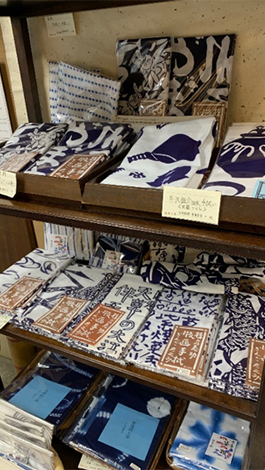
A tenugui towel based on a design drawn by Shiko Munakata.
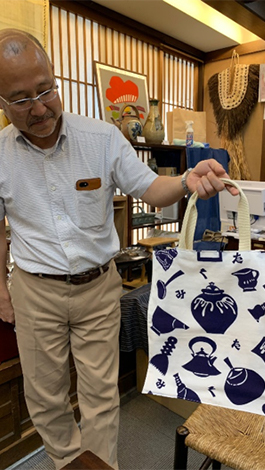
Developing a tenugui eco-bag!
I would say that TAKUMI’s strength is in local pottery from all over Japan. I had just broken my beer mug the day before the interview and. I had planned to purchase a new one at the store.
After hovering between two or three different cups, I finally decided on a Yomitanson pottery tumbler from Okinawa. I liked the blurry blue round spots on a light yellow ochre background. I visited Yomitanson Village around 15 years ago to interview the Yamuchin no Sato kiln, so I felt a certain closeness to the land.
After hovering between two or three different cups, I finally decided on a Yomitanson pottery tumbler from Okinawa. I liked the blurry blue round spots on a light yellow ochre background. I visited Yomitanson Village around 15 years ago to interview the Yamuchin no Sato kiln, so I felt a certain closeness to the land.
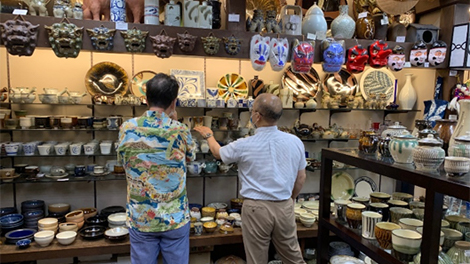
Looking for a buddy for my beer.
The other tumbler that I found difficult to choose between was from the “Hita Sarayama Onta” kiln. I liked the sound of “Onta” which soundes like a rural dialect; and the kiln had a long-established relationship with TAKUMI, where Soetsu and his Mingei movement group had often stopped by. Mr. Nozaki showed me a movie of the mountain village with beautiful terraced rice paddies. The traditional tools, including the Karausu (Chinese mortar), that use the water power from the stream in Maru-Ishigaki were also inspiring. Moreover, young craftsmen are making great efforts in these areas.
Locating the village on a map, I found it on the northern edge of Hita City in Oita Prefecture. On the other side of the mountain to the west is a small train station called Chikuzen Iwaya, but the Hita Hikosan Railway is currently out of operation due to damages caused by the heavy rain (and will be replaced by a modern bus system). I learned from a local bus app that there is a rare bus route from Hita Station to Sarayama, the entrance to Onta Kiln. This place is on my wish list of places to visit once the COVID-19 chaos is resolved.
Locating the village on a map, I found it on the northern edge of Hita City in Oita Prefecture. On the other side of the mountain to the west is a small train station called Chikuzen Iwaya, but the Hita Hikosan Railway is currently out of operation due to damages caused by the heavy rain (and will be replaced by a modern bus system). I learned from a local bus app that there is a rare bus route from Hita Station to Sarayama, the entrance to Onta Kiln. This place is on my wish list of places to visit once the COVID-19 chaos is resolved.
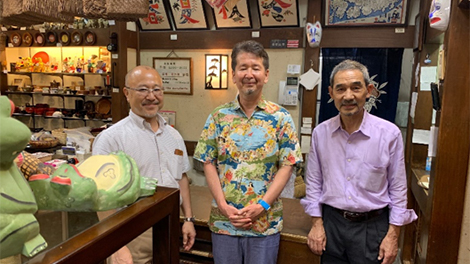
One forgets time surrounded by Mingei items from worldwide. From left, President Nozaki, Izumi-sa, Segawa-san.
All List
- Ginza×銀ぶら百年 Vol.27 Typographer in Kobikicho
- Ginza×銀ぶら百年 Vol.26 The King of Mingei on Nishiginza-dori
- Ginza×銀ぶら百年 Vol.25 To Hachimaki Okada with hopes for the restoration of Ginza
- Ginza×銀ぶら百年 Vol.24 The man who built the San-Ai building
- Ginza×銀ぶら百年 Vol.22 The Centennial of the Ginza Street Association
- Ginza×銀ぶら百年 Vol.21 The continuing strong presence of Echigoya kimono store
- Ginza×銀ぶら百年 Vol.20 The people who created Ginza’s India, “Nair’s” in Higashi-Ginza
- Ginza×銀ぶら百年 Vol.19 A visit Kyobunkwan with a sacred feeling
- Ginza×銀ぶら百年 Vol.18 Nishi Ginza, a new stylish way
- Ginza×銀ぶら百年 Vol.17 Ginza Toraya’s Panama Hat
- Ginza×銀ぶら百年 Vol.16 TEIMEN and the Ginza Ivy Era
- Ginza×銀ぶら百年 Vol.15 Christmas with Peco-chan
- Ginza×銀ぶら百年 Vol.14 It’s summer! Beer! The LION!
- Ginza×銀ぶら百年 Vol.13 The Yoshida Croquette Soba Legend
- Ginza×銀ぶら百年 Vol.12 Sasaki Shoten, retailer of pipes and “Tsuya-fukin”
- Ginza×銀ぶら百年 Vol.11 Memories of Gekkoso and Dried Sardines
- Ginza×銀ぶら百年 Vol.10 A visit to Taimei Elementary School, king of elementary schools
- Ginza×銀ぶら百年 Vol.09 A Senbei Store in Ginza
- Ginza×銀ぶら百年 Vol.08 Advertisements of Ginza in 1911 (Meiji 44)
- Ginza×銀ぶら百年 Vol.07 The mysteries of a legendary panoramic building, TENKADO
- Ginza×銀ぶら百年 Vol.06 A History Lesson at SAEGUSA
- Ginza×銀ぶら百年 Vol.05 The secrent behind the deep-fried chicken served at Mikasa Kaikan
- Ginza×銀ぶら百年 Vol.04 Yamano Music in summer 1971
- Ginza×銀ぶら百年 Vol.03 The Ginza Apartments in Ginza 1-chome
- Ginza×銀ぶら百年 Vol.02 Memories of Olympic
- Ginza×銀ぶら百年 Vol.01 Visiting ITOYA at year’s end








